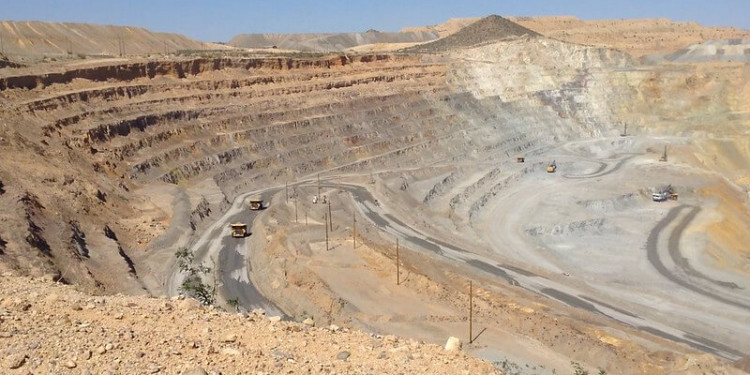
Photo by docentjoyce, Flickr.
Officials in Honduras banned open pit mining, something that has plagued the country for years
March 8, 2022
On February 28, government officials in Honduras decided to no longer grant open-pit mining permits due to the environmental concerns they pose. The new decision came soon after President Xiomara Castro took office, roughly a month after previous President Juan Orlando Hernández.
Alongside denying permits, the Ministry of Energy, Natural Resources, Environment and Mines stated they would shut down already operating open-pit mine sites.
The Ministry plans to carry out a “review, suspension and cancellation” of environmental licenses, permits and concessions that are already in effect.
How is open-pit mining harmful to the environment?
Open-pit mining is a non-tunnel approach to mining that extracts minerals by drilling a large hole or pit in the ground.
With the help of explosives, it gives workers easy access to minerals and stones near the Earth’s surface. Mining for such minerals typically includes metallic ores such as aluminum, bauxite, copper, gold, copper and iron as well as non-metallic ores including coal, uranium and phosphate.
With the help of these explosives, canyon-like holes are formed and then are converted into workable pits for extraction purposes by hefty machinery. After extraction occurs, solid and liquid waste is transferred to disposal sites nearby.
Compared to deep-shaft mining and other types of mining operations, open-pit mining is seen as safer and more efficient as pits are dug to reduce the chances of boulders falling causing injury as well as being faster than other mining operations. With the help of machinery and explosives, open-pit mining is three to five times faster than deep-shaft mining. It is estimated that as much as 20,000 tons can be mined in one day.
Despite its expedient extractive nature, open-pit mining has severe environmental impacts
Evidence of the environmental impacts of open-pit mining is overwhelming. Open-pit mining consumes massive amounts of water, pollutes local water and air, ruins landscapes and destroys habitats.
Chemicals used in the mines, including sulfuric acid and ammonium nitrate, can end up in local waterways poisoning aquatic wildlife. Long after being shut down, these open-pit mines can still continue to have adverse effects on the environment and population.
In 2009, the San Martín mine in the Valle de Siria region of south-central Honduras was closed — today the local population is still suffering from its effects. After mining the mountain, Canadian mining company Goldcorp left sulfur banks deposits open, making it easy for sulfur to mix in with rivers used for drinking water when it rains. When drinking this contaminated water, many residents found themselves sick with skin diseases and cancer.
On October 16, 2007, Luis Vidal Ramos Reina, director of forensic medicine at the Criminal and Forensic Sciences Laboratory in Tegucigalpa, released a forensic report to the Honduras government on the analysis of blood and urine samples of 61 people in Valle de Siria, where the Goldcorp open-pit mine was still operating.
The analysis found high percentages of cyanide, mercury, lead and arsenic. They also found an overwhelming high presence of lead in blood and urine samples, the concentration of lead exceeding the World Health Organization’s acceptable levels by about 10 milligrams.
The Goldcorp open-pit mining site is just one of many open-pit mining sites that have severely affected local communities. Many of these opening sites reside in rural and indigenous communities with little to almost no contribution to the local economy,
According to the Social Forum on Foreign Debt and Development of Honduras, FOSDEH, there are currently 217 mining concessions and reserves in Honduras covering 324,981 acres.
In 2020, roughly 130 of these mine sites reside on indigenous land, more than half of all mining concessions in Honduras.
With Honduras’s extensive history of abuses with open-pit mining sites, environmental and ingenious activists have been protesting the damage of open-pit mining to the environment and local communities for decades — President Castro made it a goal prior to taking office in January to limit mining.
In her election manifesto released last September, President Castro detailed 282 mining concessions handed out by previous governments through 2017, which she believes has caused failed economic policies and corruption.
Other countries have also banned open-pit mining but more needs to be done
Alongside Honduras, countries such as El Salvador and Costa Rica are the only countries that have banned open-pit mining in Central America.
Costa Rica banned opening pit mining roughly 2 decades ago in 2002, while El Salvador became the first country to ban metal mining in 2017.
Honduras joining Costa Rica and El Salvador in banning mining is a cause for celebration, but the work is not done.
Sign Up for Our Newsletter.
As open-pit mining is still widely prevalent in Central America, it is important more countries take similar steps as Honduras to ban such disastrous mining sites. Alongside eliminating open-pit mining sites, it is paramount for outside countries to stop negligent and harmful mining in poor and indigenous communities that are a hazardous threat to the local populations’ air, water and health.
This article is republished from IMPAKTER under a Creative Commons license. Read the original article.
 Copy code snippet
Copy code snippet

